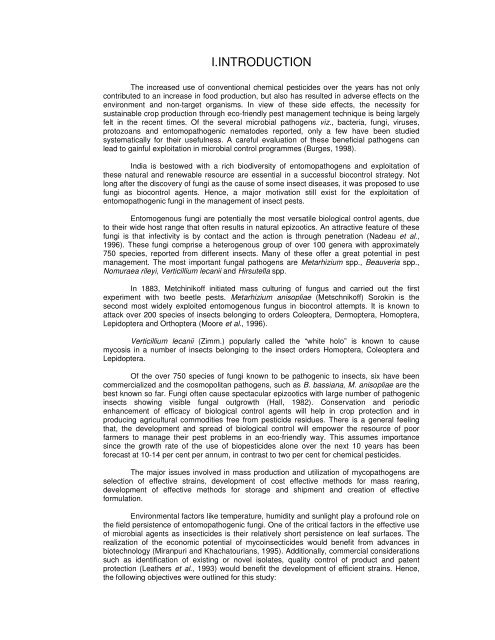ISOLATION AND CHARACTERIZATION OF ENTOMOPATHOGENIC ...
ISOLATION AND CHARACTERIZATION OF ENTOMOPATHOGENIC ...
ISOLATION AND CHARACTERIZATION OF ENTOMOPATHOGENIC ...
Create successful ePaper yourself
Turn your PDF publications into a flip-book with our unique Google optimized e-Paper software.
I.INTRODUCTION<br />
The increased use of conventional chemical pesticides over the years has not only<br />
contributed to an increase in food production, but also has resulted in adverse effects on the<br />
environment and non-target organisms. In view of these side effects, the necessity for<br />
sustainable crop production through eco-friendly pest management technique is being largely<br />
felt in the recent times. Of the several microbial pathogens viz., bacteria, fungi, viruses,<br />
protozoans and entomopathogenic nematodes reported, only a few have been studied<br />
systematically for their usefulness. A careful evaluation of these beneficial pathogens can<br />
lead to gainful exploitation in microbial control programmes (Burges, 1998).<br />
India is bestowed with a rich biodiversity of entomopathogens and exploitation of<br />
these natural and renewable resource are essential in a successful biocontrol strategy. Not<br />
long after the discovery of fungi as the cause of some insect diseases, it was proposed to use<br />
fungi as biocontrol agents. Hence, a major motivation still exist for the exploitation of<br />
entomopathogenic fungi in the management of insect pests.<br />
Entomogenous fungi are potentially the most versatile biological control agents, due<br />
to their wide host range that often results in natural epizootics. An attractive feature of these<br />
fungi is that infectivity is by contact and the action is through penetration (Nadeau et al.,<br />
1996). These fungi comprise a heterogenous group of over 100 genera with approximately<br />
750 species, reported from different insects. Many of these offer a great potential in pest<br />
management. The most important fungal pathogens are Metarhizium spp., Beauveria spp.,<br />
Nomuraea rileyi, Verticillium lecanii and Hirsutella spp.<br />
In 1883, Metchinikoff initiated mass culturing of fungus and carried out the first<br />
experiment with two beetle pests. Metarhizium anisopliae (Metschnikoff) Sorokin is the<br />
second most widely exploited entomogenous fungus in biocontrol attempts. It is known to<br />
attack over 200 species of insects belonging to orders Coleoptera, Dermoptera, Homoptera,<br />
Lepidoptera and Orthoptera (Moore et al., 1996).<br />
Verticillium lecanii (Zimm.) popularly called the “white holo” is known to cause<br />
mycosis in a number of insects belonging to the insect orders Homoptera, Coleoptera and<br />
Lepidoptera.<br />
Of the over 750 species of fungi known to be pathogenic to insects, six have been<br />
commercialized and the cosmopolitan pathogens, such as B. bassiana, M. anisopliae are the<br />
best known so far. Fungi often cause spectacular epizootics with large number of pathogenic<br />
insects showing visible fungal outgrowth (Hall, 1982). Conservation and periodic<br />
enhancement of efficacy of biological control agents will help in crop protection and in<br />
producing agricultural commodities free from pesticide residues. There is a general feeling<br />
that, the development and spread of biological control will empower the resource of poor<br />
farmers to manage their pest problems in an eco-friendly way. This assumes importance<br />
since the growth rate of the use of biopesticides alone over the next 10 years has been<br />
forecast at 10-14 per cent per annum, in contrast to two per cent for chemical pesticides.<br />
The major issues involved in mass production and utilization of mycopathogens are<br />
selection of effective strains, development of cost effective methods for mass rearing,<br />
development of effective methods for storage and shipment and creation of effective<br />
formulation.<br />
Environmental factors like temperature, humidity and sunlight play a profound role on<br />
the field persistence of entomopathogenic fungi. One of the critical factors in the effective use<br />
of microbial agents as insecticides is their relatively short persistence on leaf surfaces. The<br />
realization of the economic potential of mycoinsecticides would benefit from advances in<br />
biotechnology (Miranpuri and Khachatourians, 1995). Additionally, commercial considerations<br />
such as identification of existing or novel isolates, quality control of product and patent<br />
protection (Leathers et al., 1993) would benefit the development of efficient strains. Hence,<br />
the following objectives were outlined for this study:
















